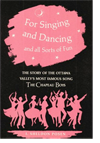For Singing and Dancing and All Sorts of Fun
Sheldon Posen, Ph.D.
$8.00 (a nominal amount to cover the cost of postage)

This book is Shelley’s Ph.D. Folklore thesis—whoa! Don’t go away: it’s actually a good read.
The book came about in this way. In 1976, Shelley was hired by Toronto’s Mariposa Folk Festival to find traditional Ontario performers. His travels took him to the central, then the eastern part of the province, then across the Ottawa River to Chapeau, Quebec, an Irish-French village where he met an extraordinary singer named Loy Gavan. Loy performed at Mariposa that year and kindled Shelley’s curiosity to learn more about what was clearly a rich community singing tradition. When it came time to do his Ph.D. field research, Shelley moved to Chapeau.
For a year and a half, Shelley hung out with the old people—and some of the young ones as well—and learned about old-time logging and singing, and farming and singing, and Christmas and singing, and – you get the idea. By the time he left, he had recorded some 120 traditional songs, including one he kept on hearing, or hearing about, over and over—the “local” song, “The Chapeau Boys.”
“The Chapeau Boys” is a winter-in-the-woods song, the kind that was composed every spring after the drive, when one of the men who’d come home from the logging camp put together a ballad describing the events—usually funny—of that season in the woods. “The Chapeau Boys,” said to have been written in the 1880s by a local man, Pat Gregg, was that kind of song, but it was unusual because instead of disappearing after a few singings, it was still being sung in Chapeau nearly a century later. When Shelley started to write about the songs and singing of Chapeau, he decided to deal first with “The Chapeau Boys.” By the time he’d written all there was to write about it, he had a dissertation’s worth.
How do you write a book on one song? You look at the song first as a piece of history—exactly when was it written, and by whom, and most important, how you prove that. Then you parse it as an example of special artistic creation, to answer the question, What is it about the way “The Chapeau Boys” was written that made it stand out from—and last longer—than any winter work song of the previous 100 years? Then you look at how it was actually performed in Chapeau-area kitchens and concert halls—differently from any other song in Chapeau, because it was nearly always performed with everyone present contributing a line or two—truly a community song. And finally, you examine its status as an icon of the community, and of the Ottawa Valley itself, which it most certainly was.
The book was published by Ottawa’s Deneau Press in 1988, its title taken from a line in “The Chapeau Boys,”
For singing and dancing and all sorts of fun,
Sure, the boys of the Chapeau cannot be outdone.
For Singing and Dancing and All Sorts of Fun helped introduce an entire generation of university folksong students and revival singers to the real way folksong works in a modern traditional Canadian community. Deneau is long gone, but Shelley has the remaining books and is pleased to offer them now, to anyone interested in owning a Canadian folklore classic, for the cost of postage.
